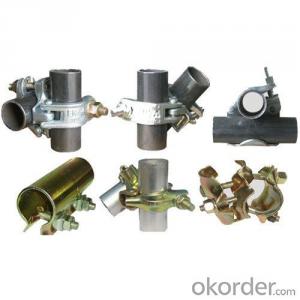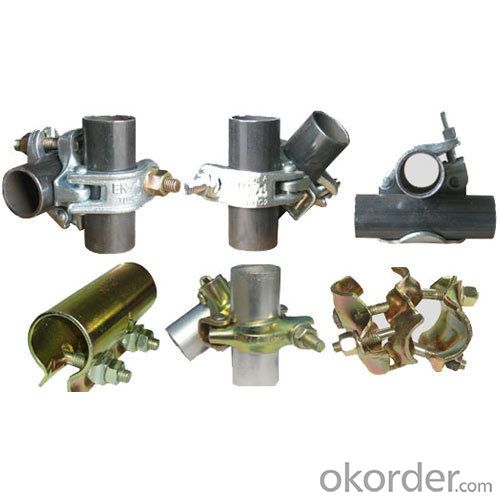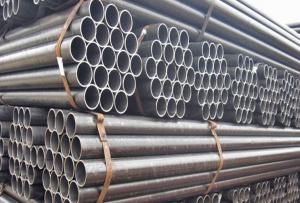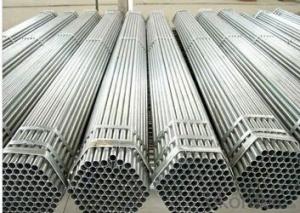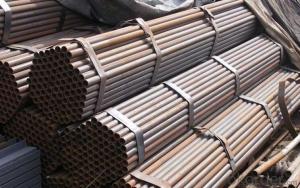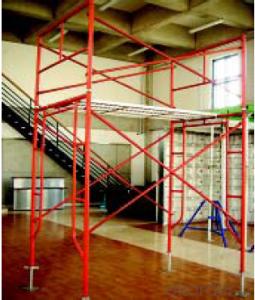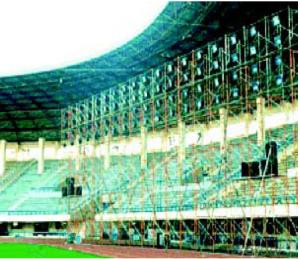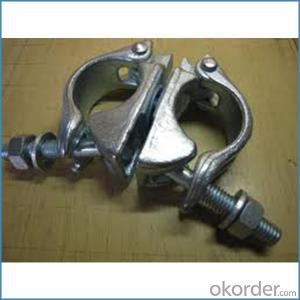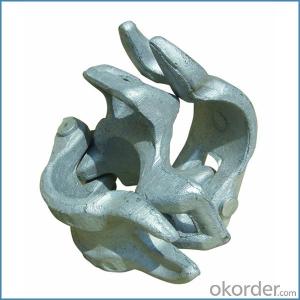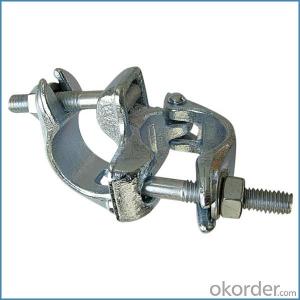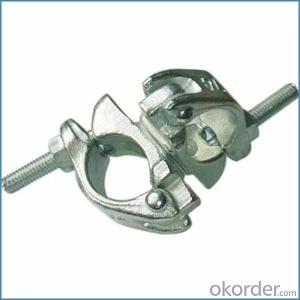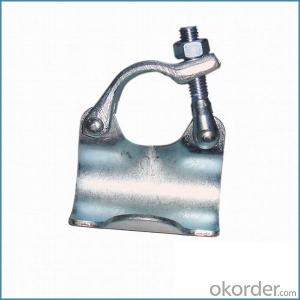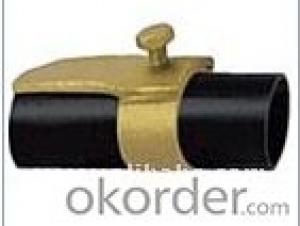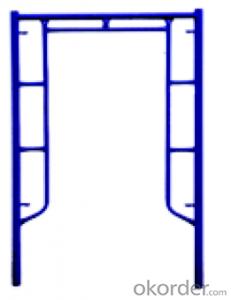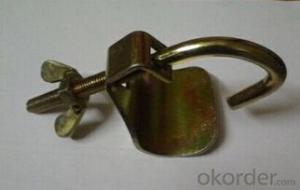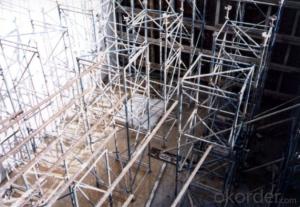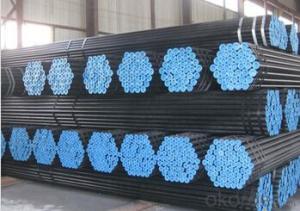Scaffolding Wedge Clamp british German Forged Type
- Loading Port:
- Tianjin
- Payment Terms:
- TT OR LC
- Min Order Qty:
- 1000 kg
- Supply Capability:
- 100000 kg/month
OKorder Service Pledge
OKorder Financial Service
You Might Also Like
Scaffolding Wedge Clamp british German Forged Type
Description
1.The scaffolding coupler is always used to connect the steel pipe as scaffolding system.
2.The often used coupler is swivel coupler and righ angle coupler .
3.We can provide types of scaffolding coupler according to your requirement.
4.Couoler can fix the 48.3mm scaffolding steel pipe tightly and make the whole scaffolding system more steadily.
Feature
(1)Excellent Anti-Breaking—Cold Pressed Steel
(2)Outstanding Resistance Deformation
(3)Strong Anti-Dropping Ability
Photo

Parameter
| Material | Q235,345steel |
| Size | 48.3mm*48.3mm |
| Surface finish | Galvanized |
| Weight | 1.1kg around |
| Standard | BS1139,EN74 |
| Package | 25pcs/bag,steel pallet |
| Manufacture | As per customer requirement |
| Market | Africa, South America, the Middle East and Asia |
FAQ
Q: Are you a factory or trading company?
We are a state-owned corporation in China,dealing with various kinds of building materials.We have our holding subsidiaries.
Q: Where is your factory located? How can I visit there?
Our factory is located all around China.
Q: Can I get some samples?
Sample is free, customer only pay freight for the first time.
Q: Delivery?
10-30days. (5-15 containers)
Any question,feel free to contact us.
- Q: Are steel tube couplers compatible with scaffolding projects involving multiple levels?
- Steel tube couplers can be used in scaffolding projects that involve multiple levels. These couplers are utilized to connect and secure steel tubes within the scaffolding structures. They have been specifically designed to establish a reliable and strong connection, which ensures the stability and safety of the entire system. Regardless of whether it is a scaffold with a single level or multiple levels, steel tube couplers can be effectively employed to construct a sturdy and enduring structure. Moreover, these couplers offer flexibility in terms of adjusting the height and configuration of the scaffold, making them suitable for projects that involve multiple levels. In conclusion, steel tube couplers are a versatile and compatible element for scaffolding projects of any size or complexity.
- Q: Are steel tube couplers adjustable to accommodate different tube diameters?
- No, steel tube couplers are not typically adjustable to accommodate different tube diameters. Steel tube couplers are designed to provide a secure and rigid connection between two tubes of the same diameter. They are manufactured to fit specific tube sizes and cannot be adjusted to accommodate different diameters. If you need to connect tubes of different diameters, you would typically need different couplers that are specifically designed for those particular sizes.
- Q: How do steel tube couplers ensure the stability of scaffolding structures?
- The stability of scaffolding structures is ensured by steel tube couplers, which create a secure connection between the different components of the system. These couplers, typically made of high-quality steel, are designed to withstand the heavy loads and forces experienced during construction or maintenance work. One method by which steel tube couplers guarantee stability is by establishing a reliable connection between the vertical and horizontal tubes of the scaffolding structure. They are commonly used to join the tubes at right angles, forming a sturdy and inflexible framework. The tight grip of the couplers on the tubes prevents the structure from wobbling or swaying during use, thus maintaining stability. Furthermore, steel tube couplers offer flexibility and adjustability within the scaffolding system. They facilitate the easy assembly and disassembly of scaffolding components, making it possible to customize the structure to suit different job requirements and site conditions. This adjustability ensures that the scaffolding remains stable and secure, regardless of changes in height, shape, or layout. Moreover, safety is a priority in the design of steel tube couplers. They are often equipped with locking mechanisms or bolts to prevent accidental dislodgement or separation of the tubes. This additional security reduces the risk of structural failure and ensures the scaffolding remains stable throughout the project. In conclusion, steel tube couplers play a crucial role in maintaining the stability of scaffolding structures. They establish a strong and secure connection between the various components, offering flexibility, adjustability, and safety. By using these couplers, scaffolding systems can withstand heavy loads, maintain stability, and provide a safe working environment for construction workers.
- Q: Can steel tube couplers be used in scaffolding projects with limited access to safety harness attachment points?
- Indeed, scaffolding projects with restricted access to safety harness attachment points can still utilize steel tube couplers. In scaffolding systems, these couplers are commonly employed to connect and secure scaffold tubes together, thus ensuring structural stability and support. Their design allows for the safe joining of tubes at various angles and configurations, resulting in a robust scaffolding structure. In cases where limited access to safety harness attachment points exists, alternative approaches can be employed to guarantee worker safety. One possibility is the use of fixed anchor points or tie-off points that are securely affixed to the scaffold structure. These anchor points can be strategically positioned at intervals along the scaffolding, offering workers suitable locations to connect their safety harnesses. Another option is to incorporate specialized scaffolding accessories, such as adjustable beam clamps or beam anchors, onto horizontal or vertical beams. These accessories can serve as additional attachment points for safety harnesses, granting workers greater flexibility in finding appropriate areas to secure themselves. Ensuring safety in scaffolding projects is paramount, and strict adherence to safety regulations and guidelines is of utmost importance. While steel tube couplers can effectively be utilized in scaffolding projects with limited access to safety harness attachment points, it is crucial to consult experienced professionals and adhere to industry best practices to guarantee worker safety at all times.
- Q: How do steel tube couplers ensure the horizontal alignment of scaffolding tubes?
- Steel tube couplers ensure the horizontal alignment of scaffolding tubes by providing a secure and rigid connection between two tubes. These couplers are designed to fit over the ends of two tubes and are tightened using bolts or pins, creating a solid joint. The design of the coupler ensures that it holds the tubes in a straight line, preventing any movement or misalignment. This is crucial for maintaining the structural integrity and stability of the scaffolding system. Additionally, the steel material used in the construction of these couplers adds strength and durability to the joint. It can withstand heavy loads and resist any forces or vibrations that may cause the tubes to shift or move out of alignment. Furthermore, steel tube couplers are available in various types, such as double couplers, swivel couplers, and putlog couplers, allowing for different configurations and connections. This versatility enables scaffolding to be customized and adjusted according to specific project requirements. In summary, steel tube couplers are essential components in scaffolding systems as they ensure the horizontal alignment of tubes. Their secure and rigid connection, along with the strength and durability of the steel material, provides stability and structural integrity to the scaffolding structure.
- Q: I was doing steel grille, ready to erect a fastener full scaffolding, an area of .100 square meters, 6m high. Need the length of the tube length? How many buckle?
- In China, bamboo scaffolding in small and medium construction units is more common, one is very low cost, 2 lighter than the steel scaffolding
- Q: Are steel tube couplers resistant to impact and shock loads?
- Yes, steel tube couplers are generally resistant to impact and shock loads. The strong and durable nature of steel makes it capable of withstanding high levels of impact and shock without deformation or failure.
- Q: Extrusion polystyrene gypsum composite panel wall insulation system performance and construction points which
- We must first consider the thickness of the substrate and peritoneal coating, better color plate substrate is 0
- Q: What are the common sizes of steel tube couplers?
- The common sizes of steel tube couplers vary depending on the specific application and industry. However, there are some standard sizes that are widely used. In general, steel tube couplers are available in various diameters, ranging from small sizes of around 1/2 inch (12.7 mm) to larger sizes of 4 inches (101.6 mm) or more. These sizes are commonly used in plumbing, construction, and industrial applications. For example, in plumbing and irrigation systems, steel tube couplers are often found in sizes like 1/2 inch, 3/4 inch, 1 inch, and 1 1/4 inch. These smaller sizes are suitable for connecting pipes and tubes in residential and commercial plumbing installations. In construction and structural applications, larger steel tube couplers are commonly used. Sizes such as 2 inches, 3 inches, and 4 inches are frequently utilized to connect steel pipes or tubes in building frames, scaffolding, or other structural support systems. It is important to note that these sizes are not exhaustive, and there may be additional sizes available depending on the manufacturer or specific project requirements. It is always recommended to consult the relevant standards or specifications when selecting the appropriate size of steel tube couplers for a particular application.
- Q: Do steel tube couplers require any specific training for installation and usage?
- Yes, steel tube couplers typically require specific training for installation and usage. It is important to have a good understanding of the coupler's design, installation procedures, and safety protocols to ensure proper installation and usage. Training helps to minimize the risk of errors, increases efficiency, and ensures compliance with industry standards and regulations.
Send your message to us
Scaffolding Wedge Clamp british German Forged Type
- Loading Port:
- Tianjin
- Payment Terms:
- TT OR LC
- Min Order Qty:
- 1000 kg
- Supply Capability:
- 100000 kg/month
OKorder Service Pledge
OKorder Financial Service
Similar products
Hot products
Hot Searches
Related keywords
